紋付袴(もんつきはかま)は、日本の男性における最も格式高い第一礼装です。その起源は江戸時代の武士の礼装にまで遡り、以来、結婚式や成人式といった人生の重要な節目で着用され、着用する人の品格と威厳を際立たせてきました。黒を基調とした厳かな姿は、単なる衣装ではなく、日本の伝統文化と精神性を象徴する存在と言えるでしょう。しかし、その構成や家紋に込められた意味、正しい着こなしのルールについて、詳しく知る機会は少ないかもしれません。
- 五つの紋が語る家族の絆: 背中、両胸、両袖に配された五つの家紋は、単なる飾りではありません。それぞれがご先祖様、両親、そして兄弟姉妹や親族を象徴し、一族の繋がりと守護を意味しています。
- 「羽二重」に宿る究極の格式: 最も格式高いとされる黒紋付には、「羽二重(はぶたえ)」という最高級の絹織物が用いられます。その滑らかで光沢のある質感は、見た目の美しさだけでなく、着る人の格を最大限に高める役割を担っています。
- 伝統と革新の交差点: 現代では、伝統的な黒紋付だけでなく、紺やグレー、さらには明るい色合いの「色紋付」も登場し、着用シーンや個性に合わせた選択肢が広がっています。伝統を重んじつつも、時代と共に進化を遂げているのです。
武士の礼装から庶民の晴れ着へ
紋付袴のルーツは、江戸時代に武士が着用していた「略礼服」にあります。当時は、これが最も格式の高い服装というわけではありませんでした。しかし、江戸時代中期になると、黒紋付の羽織袴が武士の正装として定着します。
この流れが庶民にも広まったのは、明治時代に入ってからです。裕福な商人たちが、結婚式やお葬式といった大切な儀式の際に、武士の正装に倣って紋付袴を着用し始めたのです。これが、現代に続く「第一礼装」としての紋付袴の始まりであり、人生の晴れの舞台で着用される特別な衣装としての地位を確立しました。
格式をまとう紋付袴の構成要素
紋付袴は、複数の和服を組み合わせて構成されており、それぞれに役割と意味があります。
まず、最も内側に着るのが「長着(ながぎ)」と呼ばれる着物です。その上に、腰から下を覆う「袴(はかま)」を着用します。袴には、縞模様の「仙台平(せんだいひら)」が最も格式高いとされていますが、無地のものもあります。
そして、最も外側に羽織るのが「紋付羽織(もんつきばおり)」です。この羽織に、後述する五つの家紋が入ることで、第一礼装としての格が完成します。小物は、白で統一するのが基本です。白い「足袋(たび)」を履き、「角帯(かくおび)」を締め、「羽織紐(はおりひも)」を結び、手には白い「扇子(せんす)」を持ち、足元は「雪駄(せった)」を履くのが正式なスタイルです。
家紋に込められた想いと守るべきマナー
紋付袴の最大の特徴は、その名の通り「家紋」にあります。正式な紋付袴には、背中の中心、両胸、両袖の背中側の計五か所に家紋が染め抜かれます。これを「五つ紋」と呼び、最も格式が高いものとされています。
この五つの紋には、それぞれ意味が込められています。
- 背紋(せもん): ご先祖様を象徴します。
- 抱き紋(だきもん): 両胸にある紋で、両親を象徴します。
- 袖紋(そでもん): 両袖にある紋で、兄弟姉妹や親族を象徴します。
紋付袴を着用することは、一族の歴史と想いを背負い、家族からの守護に感謝するという意味合いも持つのです。
着用時のマナーとしては、まず姿勢を正すことが重要です。背筋を伸ばし、顎を少し引くことで、凛とした立ち姿になります。歩く際は大股で歩かず、歩幅を小さくすることで着崩れを防ぎ、優雅な印象を保つことができます。
現代に息づく伝統と新たな潮流
今日、紋付袴は主に結婚式の新郎、成人式、そして大学の卒業式などで着用されています。これらの特別な日に、日本の伝統的な正装を身にまとうことで、新たな門出を厳粛かつ華やかに祝うことができます。
近年では、伝統的な黒一色のスタイルだけでなく、紺、白、グレーといった様々な色の「色紋付袴」も人気を集めています。これらは黒紋付よりは格が下がりますが、個性を表現できる略礼装として、お色直しやパーティーシーンなどで選ばれることが増えています。また、羽織や袴にモダンなデザインを取り入れた新しいスタイルの紋付袴も登場しており、伝統文化が現代の感性と融合しながら、次世代へと受け継がれています。
解説ポイント①:五つの紋が語る家族の絆
紋付袴の「五つ紋」が象徴する家族の絆は、単なる概念ではありません。背中にある「背紋」は、自分自身のルーツであるご先祖様を表します。古来、災厄は背後から忍び寄ると考えられており、ご先祖様の紋を背負うことで身を守るという意味合いがありました。心臓に近い両胸の「抱き紋」が両親を象徴するのは、命の源であり、常に自分を支えてくれる存在への敬意を示しています。そして、左右の腕に位置する「袖紋」は、共に育ち、助け合う兄弟姉妹や親族との繋がりを表しているのです。このように、五つの紋を身にまとうことは、自分一人が主役なのではなく、家族や一族全体に支えられ、その歴史の一部として儀式に臨むという、日本的な価値観を体現していると言えるでしょう。
解説ポイント②:「羽二重」に宿る究極の格式
「黒五つ紋付き羽織袴」が男性の第一礼装とされる上で、その素材である「羽二重」は欠かせない要素です。「絹のよさは羽二重に始まり羽二重に終わる」とまで言われるこの絹織物は、経糸(たていと)を2本同時に織り機の筬(おさ)に通して織ることで、非常に滑らかで、それでいて地厚で丈夫な生地が生まれます。そのしなやかな風合いと上品な光沢は、他の素材では表現できない気品と重厚感を醸し出します。黒という色は、他のどんな色にも染まらないことから、強い決意や厳粛さを示す色とされてきました。この黒を最も深く、美しく表現できるのが羽二重であり、手間暇をかけて染め上げられた漆黒の紋付は、着用する人の社会的地位や儀式への敬意を最大限に示すための、まさに究極の生地なのです。
解説ポイント③:伝統と革新の交差点
現代において、紋付袴はその伝統的な役割を維持しつつも、多様化するニーズに応える形で進化しています。結婚式において、新婦がお色直しでカラードレスや振袖を着る際に、新郎もそれに合わせて黒以外の「色紋付」を着用するスタイルが定着してきました。紺や白、グレー、茶といった落ち着いた色合いから、より華やかな色のものまで選択肢は様々です。これにより、新郎新婦の衣装の格を揃えつつ、会場の雰囲気やテーマに合わせたコーディネートが可能になりました。さらに、伝統的な柄だけでなく、モダンなデザインや、異なる素材を組み合わせた紋付袴も登場しています。これは、紋付袴が単なる「由緒ある礼装」として固定化されるのではなく、現代を生きる人々の感性を取り入れながら、文化として生き続けている証拠と言えるでしょう。
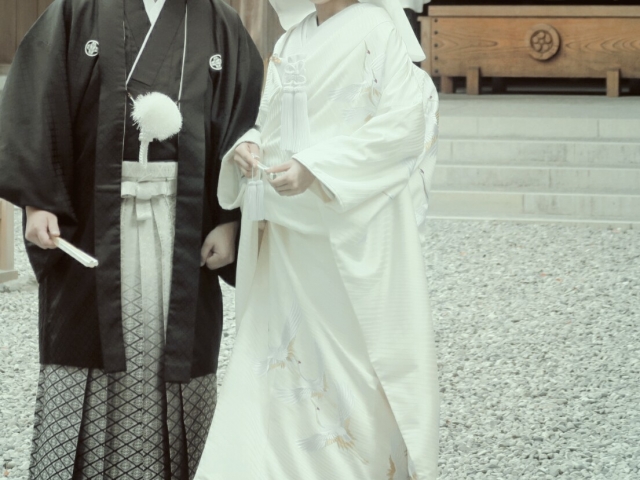
参考文献
- 紋付袴って何?歴史や格式、卒業式当日トイレの仕方まで | 京都さがの館
- 結婚式の正装!紋付袴について解説 – みんなのブライダル
- 紋付羽織袴とは?その特徴や選び方などについてもわかりやすく説明 – きものレンタリエ
- 家紋の意味~着物の紋にはどういう意味がある? – きもの永見
- 【プロが伝授】成人式を控える男性必見!紋付袴の選び方とレンタルのコツ | ゆめや通信
【English Article】
Welcome to the World of Montsuki Hakama: A Garment of Dignified Tradition
The Montsuki Hakama is the highest form of formal attire for men in Japan. Its origins trace back to the ceremonial dress of the samurai during the Edo period. Since then, it has been worn on significant life occasions such as weddings and coming-of-age ceremonies, enhancing the dignity and prestige of the wearer. The solemn, black-based appearance is more than just clothing; it is an entity that symbolizes Japan’s traditional culture and spirituality. However, opportunities to learn in detail about its components, the meaning behind the family crests, and the proper etiquette for wearing it are few and far between.
- The Five Crests That Tell a Family’s Story: The five family crests arranged on the back, chest, and sleeves are not mere decorations. Each symbolizes one’s ancestors, parents, and siblings/relatives, signifying the bonds and protection of the clan.
- The Ultimate Formality Residing in “Habutae” Silk: The most formal black montsuki uses a top-grade silk fabric called “Habutae.” Its smooth, lustrous texture not only offers visual beauty but also plays a role in maximizing the wearer’s status.
- The Intersection of Tradition and Innovation: In modern times, in addition to the traditional black montsuki, “Iro-Montsuki” (colored montsuki) in shades of navy, gray, and even brighter hues have emerged, expanding the options to suit the occasion and individual personality. The tradition is evolving with the times while being respected.
From Samurai Attire to a Commoner’s Ceremonial Dress
The roots of the Montsuki Hakama can be found in the “ryaku-reifuku” (informal ceremonial wear) worn by samurai during the Edo period. At that time, it was not considered the most formal attire. However, by the mid-Edo period, the black montsuki with a haori jacket and hakama became established as the formal dress for samurai.
This custom spread to the common people during the Meiji era. Wealthy merchants began to wear Montsuki Hakama for important ceremonies like weddings and funerals, modeling their attire after the formal dress of the samurai. This marked the beginning of the Montsuki Hakama as the “dai-ichi reisō” (first-class formal wear) we know today, establishing its status as a special garment worn on the grandest stages of life.
The Components of the Montsuki Hakama: Dressed in Formality
The Montsuki Hakama is a combination of several Japanese garments, each with its own role and meaning.
First, the innermost garment is a kimono called “nagagi.” Over this, the “hakama,” a long, pleated skirt-like garment, is worn from the waist down. For the hakama, the striped “Sendai-hira” silk is considered the most formal, though plain versions also exist.
Finally, the outermost layer is the “montsuki haori,” a jacket bearing the family crests. It is the five crests on this haori that complete its status as first-class formal wear. The accessories are fundamentally all white. The formal style includes wearing white “tabi” (socks), tying a “kaku-obi” (sash), fastening the “haori-himo” (jacket ties), holding a white “sensu” (folding fan), and wearing “setta” (sandals) on the feet.
The Sentiments in the Crests and the Etiquette to Uphold
The most defining feature of the Montsuki Hakama is, as the name suggests, the “mon” or family crest. A formal Montsuki Hakama has five crests dyed onto it: one in the center of the back, one on each side of the chest, and one on the back of each sleeve. This is called “itsu-tsu-mon” and is considered the most formal arrangement.
Each of these five crests holds a specific meaning:
- Se-mon (Back Crest): Symbolizes one’s ancestors.
- Daki-mon (Chest Crests): The two crests on the chest symbolize one’s parents.
- Sode-mon (Sleeve Crests): The crests on the sleeves symbolize siblings and close relatives.
Wearing a Montsuki Hakama also implies carrying the history and feelings of one’s clan and expressing gratitude for the protection of one’s family.
As for etiquette, maintaining good posture is paramount. Standing straight with the chin slightly tucked in creates a dignified appearance. When walking, one should take smaller steps rather than large strides to prevent the garment from becoming disarranged and to maintain an elegant impression.
Living Tradition and New Currents in the Modern Era
Today, the Montsuki Hakama is primarily worn by grooms at weddings, at coming-of-age ceremonies, and at university graduation ceremonies. Wearing this traditional formal attire on these special days allows for a solemn yet splendid celebration of a new chapter in life.
In recent years, “Iro-Montsuki Hakama” in various colors such as navy, white, and gray have gained popularity alongside the traditional all-black style. While slightly less formal than the black montsuki, they are increasingly chosen for receptions and parties as a form of semi-formal wear that allows for personal expression. Furthermore, new styles incorporating modern designs on the haori and hakama are emerging, demonstrating that this traditional culture is being passed down to the next generation by fusing with contemporary sensibilities.
Analysis Point ①: The Five Crests That Tell a Family’s Story
The family bond symbolized by the “itsu-tsu-mon” (five crests) of the Montsuki Hakama is not just a concept. The “se-mon” on the back represents one’s ancestors, the root of one’s being. In ancient times, it was believed that misfortune approached from behind, and bearing the ancestral crest on one’s back was thought to provide protection. The “daki-mon” on the chest, close to the heart, symbolize one’s parents, showing respect for the source of one’s life and their constant support. Finally, the “sode-mon” on each arm represent the connection with siblings and relatives who grow up and support one another. Thus, to wear the five crests is to embody the Japanese value of not being the sole protagonist, but of approaching a ceremony supported by one’s entire family and clan, as a part of their history.
Analysis Point ②: The Ultimate Formality Residing in “Habutae” Silk
For the “Kuro Itsu-tsu-mon-tsuki Haori Hakama” (black five-crested haori and hakama) to be considered the highest formal wear for men, its material, “Habutae” silk, is an indispensable element. This silk fabric, so renowned that it is said “the quality of silk begins and ends with Habutae,” is woven by passing two warp threads through the reed of the loom at once. This process creates a fabric that is exceptionally smooth, yet thick and durable. Its supple texture and elegant luster produce a sense of dignity and gravitas that cannot be replicated by other materials. The color black, unable to be dyed over by any other color, has long been used to signify strong resolve and solemnity. Habutae is the fabric that can express this black most deeply and beautifully. A jet-black montsuki, dyed with great care and effort, is truly the ultimate fabric for maximizing the wearer’s social standing and respect for the ceremony.
Analysis Point ③: The Intersection of Tradition and Innovation
In contemporary times, the Montsuki Hakama, while maintaining its traditional role, is evolving to meet diverse needs. At weddings, it has become common for the groom to wear a colored “Iro-Montsuki” to match the bride when she changes into a colored dress or furisode kimono for the reception. The options range from subdued colors like navy, white, gray, and brown to more vibrant hues. This allows the couple to match the formality of their attire while coordinating with the venue’s atmosphere and theme. Furthermore, Montsuki Hakama featuring modern designs and combinations of different materials are also appearing. This shows that the Montsuki Hakama is not merely fossilized as “venerable formal wear,” but is a living culture that continues to incorporate the sensibilities of people today.
References
- Montsuki Hakama tte Nani? Rekishi ya Kakushiki, Sotsugyōshiki Tōjitsu Toire no Shikata made | Kyoto Saganokan
- Kekkonshiki no Seisō! Montsuki Hakama ni tsuite Kaisetsu – Minna no Bridal
- Montsuki Haori Hakama to wa? Sono Tokuchō ya Erabikata nado ni tsuitemo Wakariyasuku Setsumei – Kimono Rentalier
- Kamon no Imi ~ Kimono no Mon ni wa Dōiu Imi ga Aru? – Kimono Nagami
- 【Pro ga Denju】Seijinshiki wo Hikaeru Dansei Hikken! Montsuki Hakama no Erabikata to Rentaru no Kotsu | Yumeya Tsushin

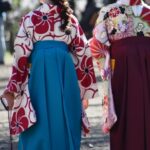
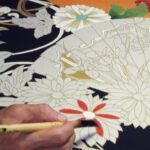
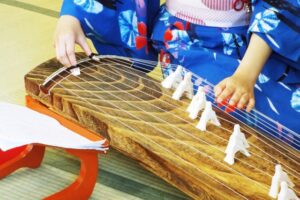
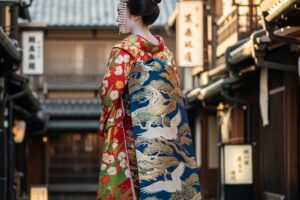
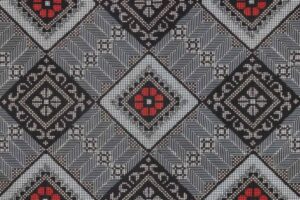


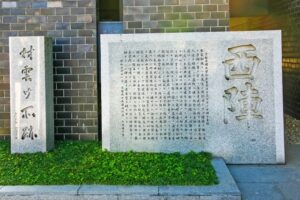

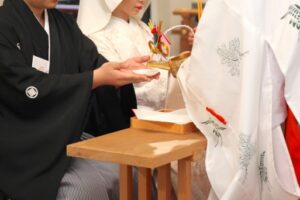
コメントを残す